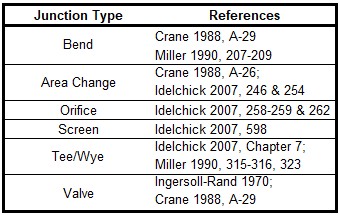K Factor Loss Model
AFT Arrow models component losses according to the following equation:
where K is commonly referred to as the loss factor. Note that for calculation purposes this pressure loss is a stagnation pressure loss.
Table 1 lists the sources for the loss models used in AFT Arrow. The losses implemented directly in the code were chosen on the basis of ease of use. Many loss factor types are functions of the flow, and thus too general to be easily incorporated.
Table 1: Loss model references

Crane (1988)Crane Co., Flow of Fluids Through Valves, Fittings, and Pipe, Technical Paper No. 410, Crane Co., Joliet, IL, 1988. offers good general purpose correlations for modeling irrecoverable losses in pipe systems. A well prepared pipe flow analyst would be advised to have copies of all of these references.
Another lesser known source of loss factor information is Idelchik's Handbook of Hydraulic Resistance (Idelchik 2007Idelchik, I. E., Handbook of Hydraulic Resistance, 4th edition, Begell House, Redding, CT, 2007.). This reference is indispensable for the engineer who must make detailed hydraulic assessments of pipe systems in which so-called minor losses play a significant roll. The reference is voluminous in scope and full of tables, charts and equations for calculating loss factors for almost any pipe arrangement.
Miller's Internal Flow Systems (Miller 1990Miller, D. S., Internal Flow Systems, 2nd edition, Gulf Publishing Company, Houston, TX, 1990.) is another reference offering good general purpose hydraulic data.
K Factor Data in Compressible Flow
Most handbook K-factor data is based on incompressible flow tests or theory. Applying standard K factors to compressible flow components carries some uncertainty. There are not any universally accepted methods available to determine K-factors for truly compressible flow except in very specific situations.
Arrow offers common handbook values for K-factors, and you should use caution in how you apply the data. Also recognize that when you use the “Fittings & Losses” in pipes, computationally these K-factors are spread out along the whole pipe as distributed losses. In compressible flow, the location of a fitting along a pipe will affect the actual pressure loss since velocity is not constant along a pipe. The Fittings & Losses do not account for this.



